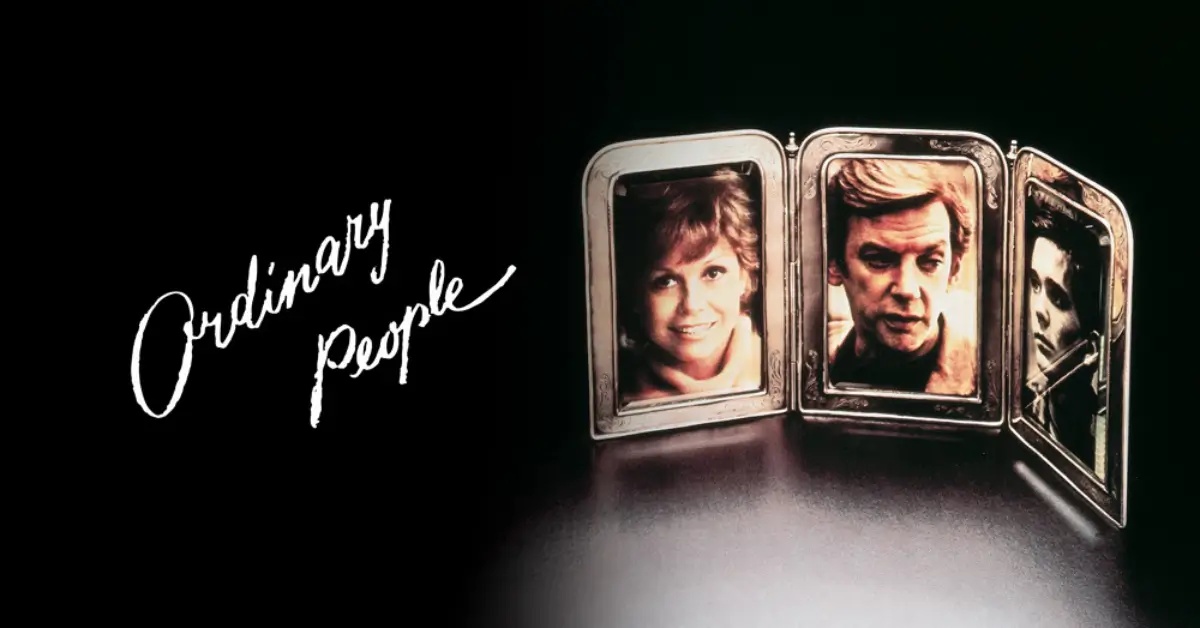Ordinary People: A Haunting Portrayal of Family Trauma and Mental Health
Introduction
Ordinary People stands as one of cinema’s most poignant explorations of grief, guilt, and mental health. This 1980 film masterfully depicts how trauma fractures family dynamics and the challenging path toward psychological healing. Through its unflinching portrayal of depression, survivor’s guilt, and familial relationships, the film provides remarkable insights into mental health struggles that remain relevant decades after its release. This analysis explores how Ordinary People delivers a nuanced representation of mental illness, ultimately advancing public understanding rather than stigmatizing those who suffer.
Thank you for reading this post, don't forget to subscribe!Basic Film Information
Title: Ordinary People
Release Date & Production Year: September 19, 1980
Director: Robert Redford (his directorial debut, showcasing his thoughtful approach to character-driven storytelling)
Screenwriter: Alvin Sargent (adapted from Judith Guest’s 1976 novel)
Main Cast & Characters:
- Donald Sutherland as Calvin Jarrett (father)
- Mary Tyler Moore as Beth Jarrett (mother)
- Timothy Hutton as Conrad Jarrett (son struggling with depression and PTSD)
- Judd Hirsch as Dr. Berger (psychiatrist)
Genre: Drama, Psychological Drama
Awards: 4 Academy Awards including Best Picture, Best Director, Best Supporting Actor (Hutton), and Best Adapted Screenplay
Runtime & Rating: 124 minutes, Rated R for mature themes and language
Plot Summary
General Overview
Ordinary People follows the Jarrett family in the aftermath of a tragic boating accident that claimed the life of their older son Buck. The surviving son, Conrad, attempts suicide and is subsequently hospitalized. The film begins with Conrad’s return home, where he struggles to reintegrate into normal teenage life while confronting overwhelming guilt and depression.
Mental Health Themes
The film delves deeply into several mental health conditions and struggles:
- Clinical depression
- Survivor’s guilt
- Post-traumatic stress disorder
- Suicidal ideation
- Family trauma and dysfunction
Key Turning Points
Conrad’s journey toward healing is marked by several crucial moments. His relationship with psychiatrist Dr. Berger forms the backbone of his recovery as he learns to express his emotions rather than suppressing them. Meanwhile, his father Calvin gradually realizes the emotional coldness of his wife Beth, who cannot connect with their surviving son. Conrad’s friendship with a fellow patient from the hospital and his tentative new romance represent small steps toward reengaging with life.
Ending Analysis
The film concludes with a family reconfiguration rather than a neat resolution. Conrad makes meaningful progress in therapy, coming to terms with his brother’s death and his own survival. Calvin acknowledges the irreparable distance between himself and Beth, who ultimately leaves the family, unable to process her grief or connect emotionally. The ending offers a realistic portrayal of mental health recovery as an ongoing process rather than a definitive cure, while still providing hope for Conrad’s future healing.
Setting & Cinematic Techniques
Filming Locations
Set in an affluent Chicago suburb, the pristine, upper-middle-class environment serves as a stark contrast to the internal turmoil experienced by the characters. The Jarrett family home immaculate and orderly symbolizes Beth’s desperate attempt to maintain appearances despite emotional devastation.
Cinematography
Cinematographer John Bailey employs a deliberately restrained visual style that emphasizes the emotional isolation of the characters. The film uses:
- Cool color palettes that reflect emotional detachment
- Carefully framed shots that often place characters at opposite ends of the frame, highlighting their psychological distance
- Intimate close-ups during therapy sessions that contrast with more distant, formal compositions in family scenes
Sound & Music
Marvin Hamlisch’s subtle, piano-driven score enhances the film’s emotional undercurrents without overwhelming them. Notably, silence is used strategically throughout the film, creating uncomfortable moments that mirror the family’s inability to communicate. The Bach piece that Conrad performs in the choir becomes a powerful motif symbolizing his emotional journey.
Acting & Character Portrayal
Lead Actor’s Performance
Timothy Hutton delivers an extraordinary performance as Conrad, capturing the complex emotional landscape of a teenager grappling with severe depression and trauma. His portrayal shows remarkable nuance from dissociative moments to explosive emotional outbursts to the subtle shifts that indicate healing. Hutton became the youngest actor to win the Academy Award for Best Supporting Actor for this role.
Supporting Cast
The film subverts audience expectations with Mary Tyler Moore’s casting against type as the emotionally frigid Beth. Her portrayal of a mother unable to process grief or connect with her surviving son is chilling and revelatory. Donald Sutherland brings tremendous empathy to Calvin, a father desperately trying to hold his family together. Judd Hirsch’s Dr. Berger offers a remarkably authentic portrayal of a therapist avoiding both Hollywood clichés and stereotypes.
Accuracy & Authenticity
The portrayal of mental health struggles in Ordinary People stands out for its realism. Conrad’s symptoms sleep disturbances, emotional numbing, flashbacks, and social withdrawal accurately reflect PTSD and depression. The film avoids melodramatic representations of mental illness, instead showing the day-to-day reality of living with psychological trauma.
Mental Health Representation: Strengths & Weaknesses
Psychological Accuracy
For a film made in 1980, Ordinary People demonstrates surprising psychological sophistication. The therapy sessions between Conrad and Dr. Berger are particularly noteworthy for their authenticity. Rather than offering magical solutions, therapy is depicted as challenging work requiring honesty and emotional vulnerability. The film acknowledges that recovery is non-linear and requires ongoing effort.
Stigmatization vs. Awareness
The film actively works against stigmatizing mental illness. Conrad’s struggles are portrayed with dignity, and his mental health issues are presented as understandable responses to trauma rather than character flaws. By placing a suburban, upper-middle-class family at its center, the film also challenges notions that mental illness only affects certain demographics.
Impact on Public Perception
Ordinary People significantly advanced public understanding of therapy, depression, and family dynamics. Released at a time when mental health was still heavily stigmatized, the film normalized seeking professional help and opened conversations about grief and psychological trauma. Its mainstream success brought these discussions into living rooms across America.
Critical Reception & Awards
Critics’ Reviews
The film received nearly universal acclaim upon release, with critics particularly praising its emotional authenticity and unflinching portrayal of family dysfunction. Roger Ebert called it “one of the most ordinary and most extraordinary films of the year,” while Pauline Kael noted its “remarkable directness in dealing with the aftereffects of a death in the family.”
Audience Reactions
Many viewers with lived experience of depression or family trauma felt validated by the film’s honest depiction of these struggles. Mental health professionals often praised its realistic portrayal of therapy and recovery.
Awards & Nominations
Beyond its four Oscar wins (Best Picture, Director, Supporting Actor, and Adapted Screenplay), Ordinary People won five Golden Globe Awards and numerous critics’ awards. Its awards recognition helped legitimize serious films about mental health in Hollywood.
Cultural & Social Impact
Discussions Sparked
The film ignited public conversations about topics previously relegated to private spaces:
- The impact of unprocessed grief on family systems
- The value of psychiatric treatment
- The unique challenges of adolescent mental health
- The pressure to maintain appearances despite emotional suffering
Influence on Other Films
Ordinary People established a template for nuanced, character-driven stories about mental health that influenced countless later films. Its commercial and critical success proved that thoughtful explorations of psychological struggles could find mainstream audiences.
Mental Health Advocacy
While not explicitly tied to advocacy organizations, the film indirectly supported mental health awareness by normalizing therapy and offering a compassionate portrayal of those struggling with psychological issues. Many therapists reported an increase in clients willing to seek help after the film’s release.
Personal Reflection & Final Thoughts
Ordinary People provides profound insight into how grief and trauma reverberate through family systems. Its most remarkable achievement is avoiding sensationalism while still conveying the devastating impact of mental illness. The film’s emotional impact comes from its truthfulness showing that even “ordinary people” in seemingly perfect circumstances can experience profound psychological pain.
For those struggling with mental health issues, the film offers both validation and hope. Conrad’s journey shows that while recovery is difficult and sometimes painful, meaningful progress is possible with proper support. The film could perhaps be improved by exploring more diverse experiences of mental health challenges, but within its focus on this particular family, it achieves remarkable depth.
Conclusion
Four decades after its release, Ordinary People remains one of cinema’s most honest and compassionate explorations of mental health. By treating its characters with dignity and psychological complexity, the film helped normalize conversations about therapy, grief, and family dynamics. Its lasting legacy lies in showing that authentic stories about mental health can be both artistically significant and accessible to mainstream audiences.
Robert Redford’s directorial debut continues to resonate because it recognizes a fundamental truth that psychological struggles are part of the human experience, not outside it. In watching the Jarrett family’s journey, we gain insight into our own emotional lives and perhaps greater empathy for those navigating similar challenges. What are your thoughts on this film’s portrayal of mental health? Does its representation still feel relevant today?

